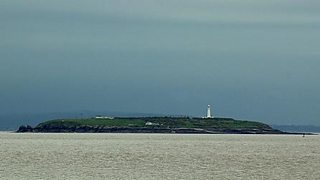The two islands of Flat Holm and Steep Holm are well-known to residents of Cardiff and the Vale of Glamorgan. Standing like sentinels guarding the eastern reaches of the Bristol Channel, , in particular, has a rich and varied history.

Flat Holm Island (photo: Gale's Photo)
The first signs of human habitation on the island date from approximately 700 BC. Legend - and it is no more than legend - says that two of the murderers of Archbishop Thomas Becket are buried there.
However, it was as a base for smugglers that Flat Holm really became famous. The best known of these smugglers was Pasco Robinson who, in the early 18th century, sailed his 40 ton sloop - complete with red mermaid figurehead - with impunity around the area.
Considering the close proximity of Flat Holm to both Cardiff and Bristol it is perhaps a little surprising to realise that, although the island was the scene of many shipwrecks over the years, it did not have a proper and effective lighthouse until Trinity House began to build their tower and light in December 1737.
That is not to say there was no previous warning beacon on the island. The Romans maintained a light there, to warn the ships of their fleet that patrolled the Channel from their base at what later became the port of Cardiff. And with a name like "Holm" - an old Norse word meaning "island in the estuary" - it is clear that the Vikings knew the place well.
Legend declares that a Viking fleet sheltered in the lee of the island after losing a battle to the Saxons at Watchet. The Vikings being such magnificent seafarers, it in inconceivable that they did not maintain a warning beacon of some sort on the small limestone outcrop.
Flat Holm became a sanctuary for St Cadoc, who apparently lived on the island for seven years. His contemporary, St Gildas, set up a base on nearby Steep Holm and the two men occasionally met up in order to say prayers.
Despite increasing maritime activity in the Bristol Channel during the 15th and 16th centuries, all attempts at building a lighthouse on Flat Holm failed dismally. It is hard to work out why this should be since there were so many terrible wrecks in the area.
On 23 October 1817, for example, 54 crew and passengers were drowned when the William and Mary foundered near Flat Holm. The victims were buried on the island.
Then, in 1736, 60 soldiers were drowned when their ship hit the Wolves, a string of rocks near Flat Holm. A certain Mr Crispe of Bristol made a proposal to Trinity House that he would pay 拢800 towards the cost of building a lighthouse. The proposal was readily accepted and at the end of 1737 work on building a tower to contain the light was begun. The lighthouse became fully operational on 25 March 1738.
Standing 98 feet high, the tower is actually 60 feet above sea level, making the light visible from well down the channel. It was certainly more effective than the original light which was a simple brazier in a wooden frame on the eastern end of the island.
The lighthouse keepers had a lucky escape in December 1790 when their tower was hit by lightning during a violent storm. They managed to avoid injury but a 10 foot crack was blasted into the side of the tower. Proof, if any were ever needed, of the dangers of the profession.
Trinity House eventually bought the lease of the lighthouse from its owners in July 1822. It was the last signal station in the United Kingdom to be privately operated and owned but, once Trinity House took over, a degree of modernisation and development began to occur. A clockwork mechanism - to rotate the light - was installed in 1881 and the station was operated by three or four keepers.
This lasted until 1988 when, like all of the other lighthouses around the coast, Flat Holm light became fully automated. By then, of course, there had been other developments on the island. In 1906 Trinity House built a foghorn station - a much needed aid to the increased level of shipping coming out of Cardiff docks due to the coal trade.
A sanatorium for seamen thought to be suffering from cholera - in effect an isolation hospital for the port and town of Cardiff - had been built on the island in 1896. The hospital, which had begun life in a tent, saw its last fatality at the end of the 19th century - from bubonic plague, What the lighthouse keepers thought of their unwelcome neighbours has not been recorded.
In the 1860s a set of barracks and gun emplacements had been built to protect the nearby port, one of many "Palmerston Follies" created around the coast of Wales. Although the barracks had been largely abandoned by the beginning of the 20th century, the island continued to have a major strategic value and was again garrisoned during World War One.
During World War Two a radar station was established on the island, and 350 members of the Royal Artillery were posted there to operate the anti-aircraft guns that had been installed.
The garrison commander, Major David Benger - later headmaster of Headlands School in nearby Penarth - invented an amazing device, known as Benger's Goalpost, which was designed to stop the guns traversing too low and thus blowing the top off the lighthouse. The lighthouse keepers would undoubtedly have been grateful for Benger's fertile imagination.
Although Flat Holm is now a Local Nature Reserve and home to many rare plants and colonies of gulls, its history is vibrant and fascinating. And the creation of the lighthouse in the 18th century undoubtedly helped to save the lives of many mariners.
